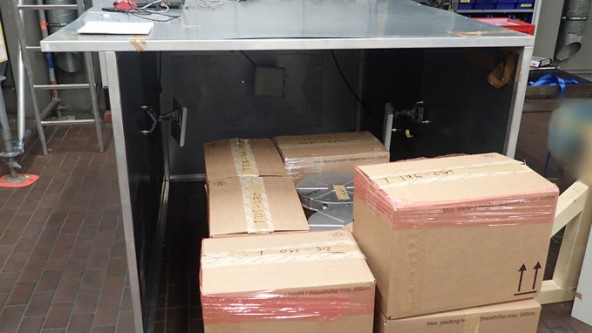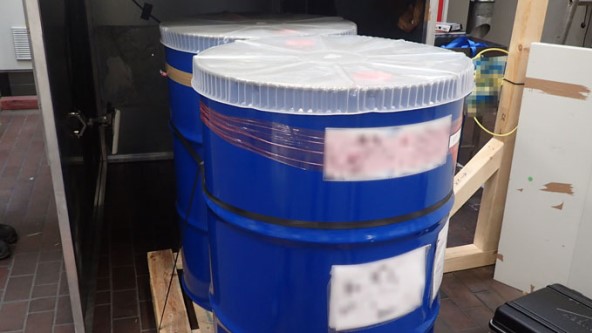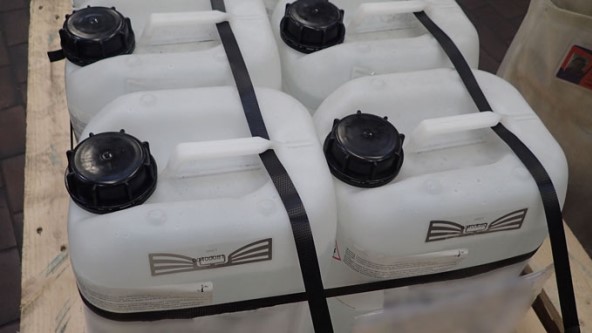Reading Device Detects Different Materials Quickly and Reliably
With its shipment verification station Turck Vilant Systems demonstrates in a proof of concept for Merck KGaA Darmstadt that containers with liquids and metal objects can be recorded reliably and quickly in UHF-RFID bulk read operations
The reliable detection of several RFID tags on a pallet is a challenge, particularly when different objects and liquids are involved. At Merck KGaA Darmstadt initial tests on the verification of shipments with conventional RFID-UHF gates showed that not all substances could be read with sufficient speed and reliability. The UHF-RFID experts from Turck Vilant Systems took up the challenge and were able to demonstrate with their shipment verification station that even ethanol containers and randomly oriented tags could be identified reliably and quickly.
As part of the digitalization of its own processes, the question was asked in Darmstadt to what extent the recording and verification of deliveries could be automated. Yanick Luca Kleppinger,, examined in his final year thesis the effect of different solvents on bulk detection with UHF-RFID technology. As part of this study Kleppinger also carried out a proof of concept with regard to the question how well different chemicals and containers can be identified with UHF-RFID technology. In the test setup for this feasibility study, he tested the technology using examples of seven pallets that reflected the variety of containers and substances.
The tests with a conventional RFID gate were promising. The detection of the ethanol pallets did however show differences to the detection of pallets with different solvents. Tags fixed to the inside of the ethanol containers in particular could not be reliably detected. The mixed pallet also presented problems for the conventional RFID gate.
Shipment verification station uses wave reflection on metal walls
The engagement of RFID integration specialists Turck Vilant Systems (TVS) brought a solution. Besides its own RFID middleware, TVS uses optimal hardware for the application at hand. “Detecting pallets with liquids in an RFID gate cannot be done with a conventional gate setup,” recalls Robert Paulus, the business development manager at TVS who took care of the proof of concept at Merck KGaA Darmstadt. The tags fixed inside were surrounded by liquids on all sides. As the ethanol still absorbs the waves, the inside tags are not detected. “We have had good results with our shipment verification station (SVS) in these kinds of applications, says Paulus. The SVS is a metal box on which the three walls and the ceiling are fitted with UHF read/write heads. The pallet with the objects to be identified is inserted through the remaining opening
Polarity critical for readability
The test with the first three pallets showed that the three solvents had a different reaction to ultra high frequency waves. While the detection of the 120 tags on the pallet containing the ethanol bottles took 30 seconds, the bottles with different solvents could be read in two seconds. The tags on the bottles were read at virtually the same speed as the tags on the cartons, and so the difference had to be in the properties of the solvent. Literature to date had only mentioned that liquids had a dampening effect on electromagnetic waves. The three liquids had similar viscosities but differed significantly in their dampening properties. Kleppinger looked for a different molecular property that differentiated the three solvents: The result of his study was the polarity of the materials was the critical factor. If this finding can be confirmed with further tests, this will represent a new level of research in future on the effect of liquids on readability with UHF-RFID.
Successful proof of concept result
With a read device like the shipment verification station the test pallets examined could be used reliably with all materials for verifying shipments at Merck KGaA Darmstadt and in very good to acceptable read times for logistical processes. Even with the most difficult substance ethanol, the bulk detection operations with read times of up to 30 seconds were impressive. When using the right on-metal tags, metal containers likewise do not present a problem.
- Motoryzacja
- Wykrywanie karoserii
- Zdecentralizowane monitorowanie stacji chłodniczych za pomocą RFID
- Cele spawalnicze robotów połączone w sieci Ethernet+
- Monitorowanie obiegu chłodzenia zacisków spawalniczych
- Monitorowanie przepływu w myjkach bębnowych
- Monitorowanie stanu silników
- Łatwe monitorowanie poziomu chłodziwa w frezarkach CNC
- Tłocznia
- Nadwoziownia
- Lakiernia
- Montaż
- Układ przeniesienia napędu
- Wykrywanie przedmiotu za pomocą UHF RFID
- Monitorowanie podawania smarów chłodzących do maszyn
- Kontrola ciśnienia hydraulicznego w tłoczniach
- Pomiar ciśnienia procesu na podnośnikach
- Warsztat blacharski – kontrola jakości końcówek spawalniczych
- Montaż końcowy – wykrywanie czarnych części na czarnym panelu drzwi
- Montaż końcowy – wykrywanie przeźroczystego szkła dachu panoramicznego
- Układy napędowe – detekcja gumowej uszczelki w bloku silnika
- Detekcja samochodów elektrycznych
- Zrealizowane aplikacje
- Samobieżne wózki 4.0
- RFID Guides AGV in Suspension Production
- Linia produkcyjna tłumików wyposażona w koncentratory połączeniowe IO/Link
- Gotowi na wyspy
- Czujniki nakrętek do przyspawania.
- Identyfikowalność RFID
- RFID w produkcji silników
- Produkcja zderzaków z identyfikacją
- Rozwiązania dla lakierni
- Czujniki spawania i montażu
- Czujniki kąta dla systemów montażowych.
- Identyfikacja narzędzi
- System Pick-to-Light przy montażu zderzaków
- Unikalny produkt przenośnika taśmowego
- RFID w hali montażu nadwozi
- Przemysł Chemiczny
- Energia
- Żywność i napoje
- Logistyka
- ZDECENTRALIZOWANE STEROWANIE MUTINGIEM ELEKTROCZUŁEGO SPRZĘTU
- KOMPAKTOWE MODUŁY WEJŚĆ / WYJŚĆ STERUJĄ SEGMENTAMI PRZENOŚNIKA ROLKOWEGO
- KONTROLA POJEMNIKÓW
- SZYBKIE WYKRYWANIE TAGÓW PRZY BRAMACH MAGAZYNOWYCH
- Wykrywanie przedmiotu za pomocą UHF RFID
- Prewencyjne utrzymanie ruchu w aplikacjach przenośników rolkowych
- Detekcja kontenerów transportowych
- DETEKCJA POZIOMU W NACZYNIACH
- IDENTYFIKACJA NACZYŃ KRIOGENICZNYCH
- IDENTYFIKACJA KONTENERÓW MOBILNYCH ZA POMOCĄ HANDHELDÓW
- IDENTYFIKACJA POJEMNIKÓW NA ŻYWNOŚĆ
- TIER 1 - IDENTYFIKACJA ZDERZAKÓW JUST-IN-SEQUENCE
- MONITOROWANIE STANU MAGAZYNÓW
- CHRONA PRZED KOLIZJĄ NA WÓZKACH WYSOKIEGO SKŁADOWANIA TYPU REACH STACKERS
- Success Stories
- BUFOROWANIE ZIEMNIAKÓW
- STEROWNIKI PLC IP67 KONTROLUJĄCE TRANSPORT W CHŁODNIACH
- STEROWANIE PRĘDKOŚCIĄ ZA POMOCĄ CZUJNIKA RADAROWEGO QT50
- ZASILACZE IP67 DO PRZENOŚNIKÓW
- Modular Conveyor System
- ROZWIĄZANIA RFID DLA MAGAZYNÓW
- RFID wspiera wózki AGV w produkcji zawiesi
- IDENTYFIKACJA RFID W PRZEMYŚLE FARMACEUTYCZNYM
- UHF RFID W CENTRUM DYSTRYBUCJI ŻYWNOŚCI
- AUTONOMICZNA POMOC PRZY PARKOWANIU CIĘŻARÓWEK
- Sprzęt mobilny
- Automatyczna kompensacja pochylenia
- Dystrybucja sygnałów w opryskach polowych
- Pomiar kąta w opryskiwaczu ciągnikowym
- Monitorowanie przepływu materiałów w kombajnie zbożowym
- Określenie położenia kąta wysięgnika
- Oświetlenie przestrzeni z osprzętem w wozach strażackich
- Dwuosiowy pomiar nachylenia kombajnu zbożowego
- Ochrona przed kolizją na wózkach wysokiego składowania typu Reach Stackers
- Success Stories
- Selektywne zbieranie szparagów z autonomicznym robotem
- Pomiar pozycji za pomocą RFID i enkodera
- Kontrola prędkości za pomocą czujnika radarowego QT50
- RFID Prowadzi wózek mobilny AGV w produkcji części do układów zawieszenia.
- Kompaktowe moduły we/wy na jachcie premium
- Wykopy na morzu
- Niech woda płynie
- Uwaga pociąg!
- Dobre połączenie
- Naprzeciw zimie
- Inteligentne dźwigi
- Wyjątkowe podnośniki
- Bezpieczne przejażdżki
- Budowanie w przyszłości
- Dokładne pozycjonowanie wysokości
- Zapobieganie kumulacjom
- Wskaźnik kąta
- Ropa i gaz
- Przemysł opakowaniowy
- Farmacja
- RFID Control of Tube Connections in the Ex Area
- Zdecentralizowana weryfikacja opakowań dla produktów farmaceutycznych przy pomocy systemu RFID
- Automate Modular Skids
- Pharmaceutical Skids with Decentralized I/O Technology
- Izolacja ex w modułowych instalacjach procesowych
- Control of Valve Interfaces
- Monitoring of Quarter Turn Actuators
- Wykrywanie kolanek rur
- Remote Signal I/O
- Planning and Construction of Super Skids
- Łatwe podłączanie urządzeń obiektowych
- Identification of Cryovessels
- Identification of Mobile Containers
- Identification of Mobile Containers with Handheld Devices
- Identification of Hose Connections for Precursors
- Identification of Hose Connections in Sterile Areas
- Identification of Hose Connections in Ex Zone 1
- Identification of Big Bags and Bioreactors
- Identification of Single-Use Applications
- Success Stories
- Bezkontaktowe przekazywanie zasilania I sygnałów dwustanowych
- HMI steruje mieszalnikiem przemysłowym
- Programowalna w codesys bramka BL20 steruje systemem do przetwarzania obrazu
- RFID Identifies Pharmaceuticals
- Speed measurement of mixing heads in magnetic stirrers
- Reading Device Detects Different Materials
- Półprzewodniki
Select Country
Turck worldwide


-turck-image.jpg)



-turck-thumbnail.jpg)


